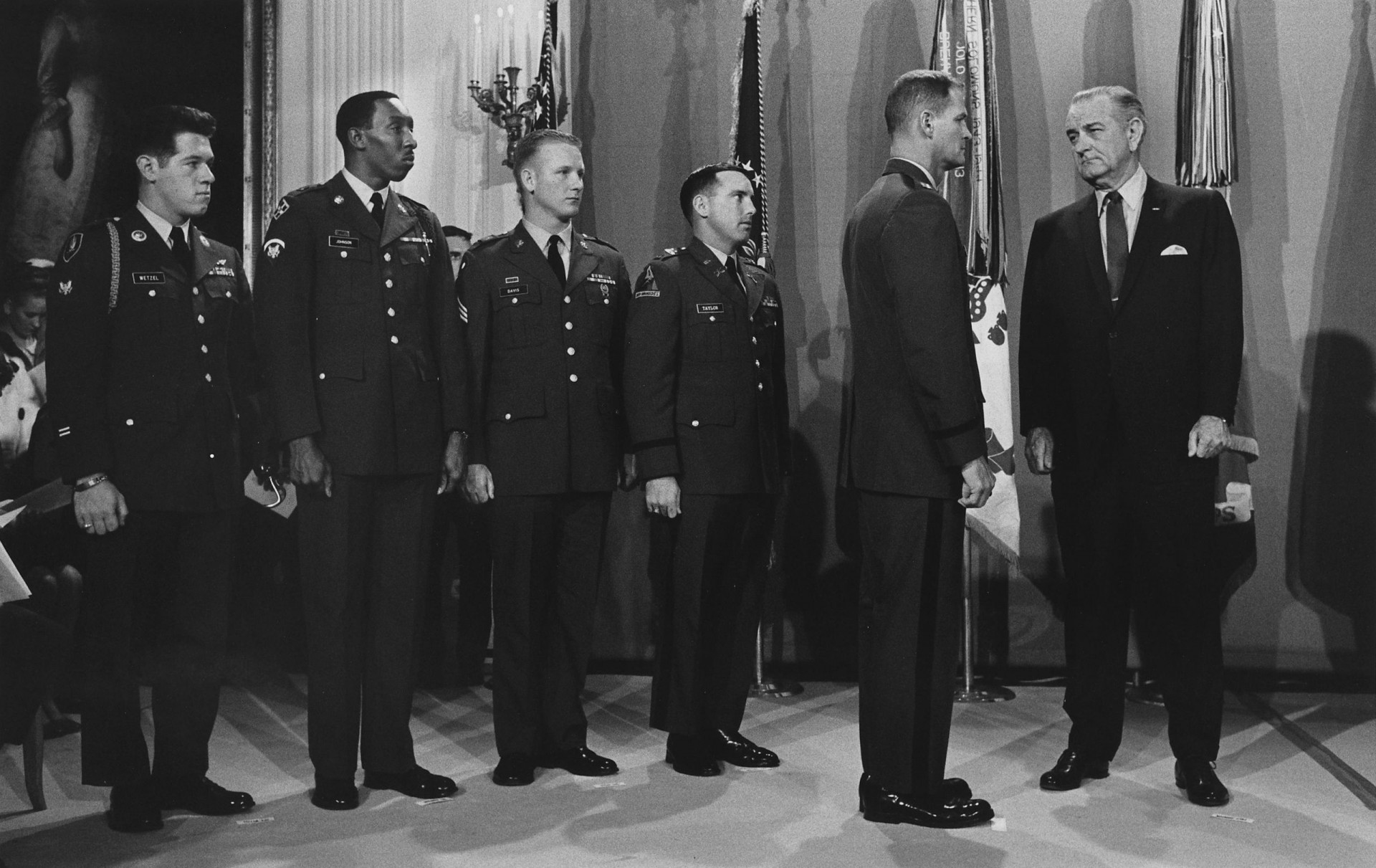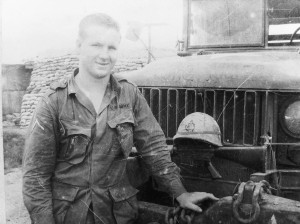
A MAN OF HONOR: Sammy Lee Davis
The crowning moment of Sammy Lee Davis’ life will live forever, though maybe not in the way he had imagined. The video of Davis receiving the Congressional Medal of Honor from President Lyndon B. Johnson in the Oval Office in 1968 was immortalized not in newsreels, but in the 1994 Academy Award winner for Best Picture, Forrest Gump. Filmmakers superimposed Tom Hanks’ head onto Davis’ body for what became an iconic scene. Ever the team player, Davis says he didn’t mind at all when producers asked to erase his face. He was just happy to help.
Of course he was. Glory, fame, and credit were not Davis’ ambitions when he joined the Army to fight in an unpopular war. Military service was simply his family’s trade; his grandfather served in the Spanish-American War, his father in WWII, and his brothers in Korea and Vietnam. Davis didn’t wait for a draft card to show up at his house. He enlisted in 1965 and was sent to Vietnam in March of 1967. Early in the morning on November 18 of that year, Davis’ 4th Artillery Regiment came under fire from three enemy units and Davis’ Howitzer was struck by an enemy mortar. He survived the initial blast only to be wounded by friendly fire; the Howitzer positioned behind Davis began firing beehive anti-personnel rounds, each of which release 1,800 small arrows.
“We had to use that to fend off the enemy because there were so many of them and so few us,” Davis says. “Unfortunately, the gun behind me, they thought we were all dead because they had seen the rocket round hit.”
It was a little after 2 am. Davis was pinned between enemy and friendly fire and suffering from a slew of injuries. Thirty beehive darts were buried in his skin, his right thigh had been shot with an AK-47, his back and sternum were broken, and the ribs on his right side were crushed. At this point, crawling to cover would have been the only sensible thing to do. Only then, Davis looked across the river and saw an American infantryman waving at him from a foxhole; he was pinned down with two other soldiers. Davis made a decision to try to help.
“In combat you learn to do for your brother what you hope they do for you,” Davis says. “I did for those three men across the river what I knew in my heart they would do for me. How could I not do that?”
Davis grabbed an air mattress to make his way across the river. “I knew how to swim but at that point knew I shouldn’t try to do it by myself,” he says.
When asked how he could make it across the river without being shot, Davis says simply, “That’s a very good question. Because they definitely saw me and they were shooting at me. I remember the water spraying all around me and I just have to thank the man above that they didn’t hit me.”
When he reached the other side, Davis stashed the air mattress and scrambled up the river bank to the foxhole. There, he found Jim Deister, Billy Ray Crawford, and Gwendell Holloway.
“Jim Deister had been shot through the head and the chest with a Chinese pistol,” Davis recalls. “We thought he was dead but I wasn’t going to leave a brother. [It turned out Deister was alive; Davis’ actions saved his life.] I pulled him up over my shoulders. I picked the other two up under my arms–they could help. We made our way back across the battlefield.”
Holloway still had three clips of M-16 ammunition but the four men were astronomically outnumbered. Waves of up to 200 enemy soldiers would charge at their position, meaning the only course of action was for all four of them to lay down and play dead.
“I would watch their eyes,” Davis says. “And when I could see them drop their weapon to do their job as a soldier, I would do mine first, and it worked. We got back to the river bank and I ferried them across. They got help on the other side.”
Davis, meanwhile, crawled back to the second Howitzer to help fire it. “I set the
fuses and we kept firing beehive.” Eventually, the Vietcong were forced to retreat from the attack.
Even 50 years after that fateful day, it’s shocking to hear Davis talk about enemy soldiers “doing their job” as if he were recapping a sporting event. But to be sure, he holds no animosity toward the men he fought against.
“For the most part, we did our job and they did their job,” Davis says. “Most of them were good soldiers and had honor. The first time I had a buddy laying out and needed help, I could see the enemy hiding in the brush line and I raised my weapon up over my head and slowly stood up and I could see that he could see me do it. I laid my weapon down so he could see it and went to help my buddy. He didn’t shoot me so I said, ‘Okay, he’s got honor.’ They started doing that too. They would hold their weapons up if they needed to help someone. There is honor among soldiers… There can be honor among soldiers.”
Receiving the Medal of Honor came with some perks. For instance, Davis had always taken a ribbing for his name being identical to the Sammy Davis Jr., the entertainer. “The guys said I had both eyes and can’t dance,” Davis laughs.
When Sammy Davis Jr. finally met the Medal of Honor recipient, he had a surprise for him. He leapt into Sgt. Davis’ arms and said, “I always wanted to meet you! You have no idea the ribbing I took because of my name!”
“We turned out to be pretty good friends,” Davis says. “From then on out, because we were out on the road travelling a lot [often to give speeches on behalf of the military] we’d be in the same town sometimes. If we were in Vegas at the same time as him, we’d go to the show and he would call me up on stage and introduce me as the real Sammy Davis.”
Not everyone back home was as welcoming. The anti-war movement in the U.S. reached
a fever pitch and soldiers often bore the brunt of protestor wrath. Being a Medal of Honor recipient only painted a bigger bullseye on Davis’ back.
“As far as the protestors were concerned, I was the one always pushed out front. And as the one pushed out front, I was the one hit by beer bottles, stones, and got all the name calling,” Davis says. “I proudly took it for my brothers because better they do it to me than to them.”
General William Westmoreland sent Davis to give a speech at an anti-war protest at Berkley College in the late 70s. Country Joe and the Fish were performing, and before they took a 10-minute break to let Davis speak, they performed their most popular song, “I Feel Like I’m Fixin’ To Die” a Vietnam War protest song that contained the lyrics, “Come on fathers, and don’t hesitate, to send your sons off before it’s too late. And you can be the first ones on your block to have your boy come home in a box.” Country Joe finished the song to rioutous applause, then took a break. Davis thought it was odd that the band took all of its equipment off the stage for such a short intermission, but realized why as soon as he stepped behind the mic.
“I was hit with beer bottles, wine bottles, everything,” Davis says. “I had a big cut over my eye I was gushing blood.” And his full dress uniform was covered in garbage and dog crap. Nevertheless, he didn’t deviate from his script, saluted the crowd when he was done and said, “God bless America.”
When he exited the stage, he was greeted by a dozen women who wanted to tell him something else. “I figured they were going to give me more of what I had just got.” Instead, they said, “We want you to know that we are here to protest the war, and not the warrior.”
“I had never heard that, so that’s what stuck in my heart each time I was exposed to such ridiculousness,” Davis says. “I realized it’s OK to protest a war, but it’s never OK to protest the warrior.”
The fact that American culture as a whole has taken to supporting soldiers, even if they disagree a particular war or war in general, gives Davis a lot of help for the future. “I encourage everyone to stand up for what they believe is right in their hearts. I don’t preach politics.”
Davis’ book, You Don’t Lose Til You Quit Trying: Lessons on Adversity and Victory from a Vietnam Veteran and Medal of Honor Recipient is available at Amazon.
His wife Dixie Davis penned her own book, which Davis describes as picking up where his book ends. It is called Endless Love and Second Chances.
Follow Davis on Twitter: @sammyldavis1946
You can learn about the Robert Irvine Foundation and it’s support of our military and their families HERE.
Originally published in the June 2016 issue of Robert Irvine Magazine.


